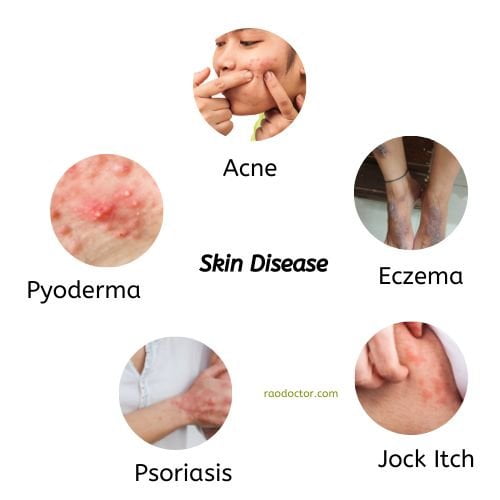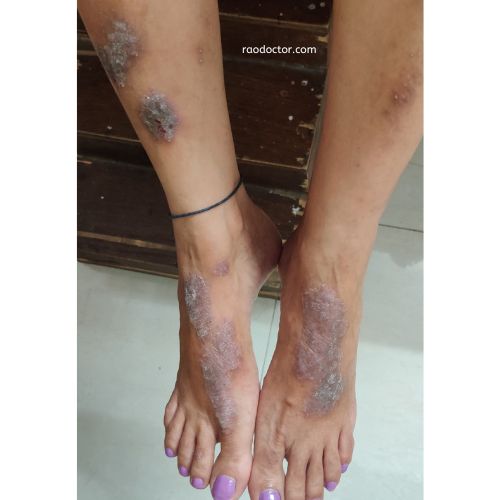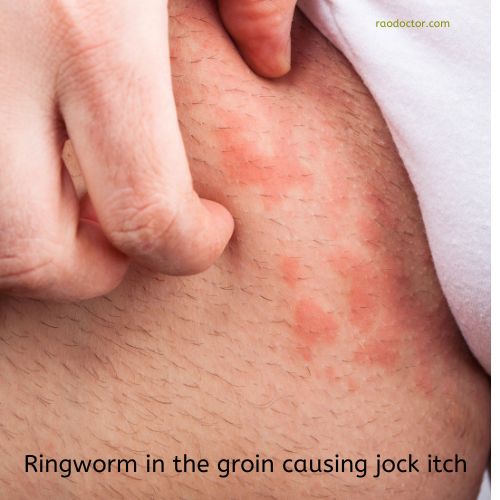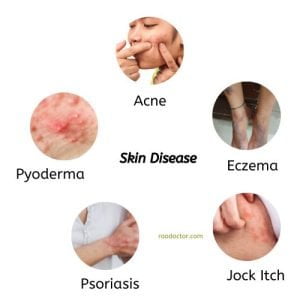Learn all about them here


In my last article on Hernia Surgery, I had made a closing remark that my next article will be on common skin diseases.
In our day-to-day life, we come across many afflictions of the skin and one of them is skin infection.
Listen to this article-
Acne, eczema, dermatitis, psoriasis, and fungal skin infections are some of the most common skin diseases encountered in daily life.
These skin diseases can be caused by bacterial infections, allergies, genetics, or other internal and external factors.
Acne is one of the most commonly found skin diseases, which affects teenagers and adults alike.
Pyoderma is a bacterial infection, common next to acne. It usually presents as pus filled blisters.
Eczema is a chronic condition that causes inflammation and irritation of the skin.
Dermatitis is an inflammation of the skin that shows up as redness or rashes.
Psoriasis is an autoimmune condition that causes the body’s immune system to attack the healthy cells in its own skin.
Fungal skin infections occur when fungal spores penetrate and grow in the outer layer of the skin resulting in rashes or lesions.
To maintain healthy skin and prevent these illnesses, one must follow a proper skincare regimen including regular cleansing, moisturizing and protecting from sun exposure.
Let us now study in short, these 5 common skin diseases we usually come across in day-to-day life. I will post detailed information on these five skin diseases in my future posts.
Acne
Acne Vulgaris is a very common skin condition that affects many people around the world. It is characterized by red, inflamed spots, usually on the face, chest, back, or shoulders.
Acne is caused by the overproduction of sebum, an oily substance that is produced by the sebaceous glands.
This excess oil clogs the pores of the skin and allows bacteria to grow, causing inflammation and the formation of pimples.
Types of Acne

There are four types of Acne Vulgaris:
- Non-inflammatory acne
- Inflammatory acne
- Cystic acne
- Conglobata acne
We will learn about these types in detail in my future post on Acne.
Acne Vulgaris can have a significant impact on a person’s self-confidence, especially when it is severe or very visible.
It is important to understand that Acne Vulgaris is not a sign of poor hygiene and is not caused by dirt or uncleanliness.
In fact, cleaning the skin too often or using harsh soaps and scrubs can make the condition worse.
Pyoderma
Pyodermas are bacterial skin infections which cause blisters filled with pus. These infections are caused by a number of different bacterial species, but staphylococcus is the most common culprit.

Staphylococcus is a type of bacteria which is found on the skin of humans, and when it is given the opportunity to get into the skin, it can cause an infection.
This infection is known as pyoderma, and it can be very painful and uncomfortable.
Pyodermas cause the skin to become swollen and red. They can also cause blisters which are filled with pus.
These blisters can be very uncomfortable and can cause a great deal of pain.
In some cases, blisters can also become severely infected and lead to more serious problems such as cellulitis or abscesses.
Eczema
Eczema is a chronic skin condition that causes itching, redness and a rash. It can be very uncomfortable and can make everyday activities difficult.
This skin disease is quite common these days. It is somewhat more prevalent in women than men. About 20% of children suffer from Eczema.
It is estimated that 1:10 individuals of the global population are suffering from eczema.
Signs and symptoms of eczema vary from person to person but may include red, itchy, dry and cracked skin. The skin may also appear scaly or leathery.

Eczema can affect any part of the body, but it is most common on the hands, face, neck, elbows and knees.
Eczema can have a variety of triggers and sometimes the cause is unknown. Common triggers include environmental factors such as irritants, food allergies and stress. It is important to identify and avoid any triggers that may cause an eczema flare-up.
There are 8 types of Eczema. We will learn about them in detail in my future article on this topic.
If eczema is not managed properly, it can lead to infection and scarring. It is important to see a doctor if the symptoms are severe and do not respond to home treatments.
The doctor may prescribe a stronger topical cream or oral medication to help control the eczema.
Eczema can be a difficult condition to manage, but with the right treatments and lifestyle changes, it is possible to keep the symptoms under control.
It is important to keep the skin moisturized, avoid triggers and seek medical help if necessary. By following these tips, it is possible to keep eczema under control and reduce the itching and rash.
Dermatitis
Dermatitis is an offshoot of eczema or rather a type of eczema. It is a skin condition that involves inflammation of the top layers of the skin.
It is most commonly characterized by redness, itching, and swelling in the affected area, but there are many different types of dermatitis with different signs and symptoms.
Atopic dermatitis is the most common type of dermatitis and is often referred to as eczema. It usually occurs in children but can also affect adults. Symptoms include dry and scaly skin, itching, and redness.

Other types of dermatitis include –
- contact dermatitis,
- seborrheic dermatitis, and
- nummular dermatitis.
We will learn all about Dermatitis in a separate post in the near future.
Psoriasis
Psoriasis is a common, chronic skin condition that affects approximately 2-4% of the population. It is a condition which is characterized by red, scaling skin patches that are usually itchy and painful.
Psoriasis can affect any part of the body, but it is most commonly found on the scalp, elbows, knees, palms, and soles of the feet.
The signs and symptoms of psoriasis vary from person to person, but usually include a red, scaly rash that is itchy and painful. The rash typically causes patches of skin to be raised and inflamed, and these patches can be itchy and painful. Other common symptoms of psoriasis include dry skin, cracking or bleeding of the skin, and thick, white patches of skin.

There are several types of psoriasis, including-
- plaque psoriasis [also known as psoriasis vulgaris],
- guttate psoriasis,
- inverse psoriasis,
- pustular psoriasis, and
- erythrodermic psoriasis.
We will study Psoriasis in detail in a post that I will be posting shortly.
Fungal skin Infection
Fungal skin infections are caused by a variety of fungi, which can result in a wide range of symptoms and signs, depending on the type of infection.
The most common types of fungal skin infections include athlete’s foot, ringworm, jock itch, and yeast infections. It is important to recognize the signs and symptoms of a fungal skin infection so that it can be treated promptly and effectively.

Athlete’s foot is a fungal skin infection of the feet and toes, caused by the fungus Trichophyton rubrum. It is characterized by itching, burning, and cracked, peeling skin. Other common signs of athlete’s foot include redness, swelling, and blisters.
Ringworm is another common type of fungal skin infection, which is characterized by an itchy, scaly, red rash that is usually circular in shape. It is caused by various fungi, including Trichophyton, Epidermophyton, and Microsporum.
Jock itch is a fungal skin infection that affects the groin area and is caused by the same fungus that causes athlete’s foot. It is characterized by an itchy, red rash that is usually found on the inner thighs, buttocks, and genital area.
Yeast infections are a type of fungal skin infection caused by the fungus Candida albicans. They are characterized by itching, burning, and redness of the skin, as well as white patches that look like cottage cheese.
Fungal skin infections can be treated effectively using local applications such as creams and ointments as well as with anti- fungal soaps. Severe cases may need oral anti- fungal medicines.
We will learn in detail about all the above-mentioned fungal infections in a separate post in future.
You can also learn about a few more skin conditions here-
Conclusion
I hope you have found this article useful. If yes, please share on social media by clicking the icons at the bottom of this article or Click to Tweet-
5 common skin diseases one should know about Share on XMy next article will be an introduction to some common gastrointestinal conditions we face in our day-to-day life.

